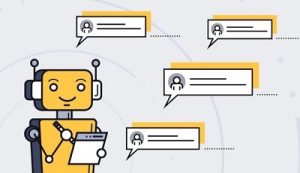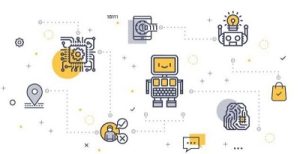Chatbot API
Chatbot APIs: A Comprehensive Comparative Analysis
Chatbot API: What are they today?
Artificial intelligence is rapidly expanding! As a present trend toward using machine-based prediction and decision-making in information technology, not as a distant future uprising of robots (chatbot APIs) against their human creators. Self-driving cars, intelligent image processing (like Prisma), and the usage of communication domains like conversational AI, often known as chatbot APIs, are all examples of how pervasive the AI hype is.
Though the technologies are still in their infancy, the chatbot API market is growing quickly. Like the classic text game “I Smell a Wumpus,” chatbots used to be somewhat lifeless, but have now developed into effective commercial tools. For the purpose of exploring information and getting services, chatbot API provides a brand-new kind of straightforward and user-friendly interface. IT professionals and significant players in the market, like Google, Microsoft, and Facebook, concur that this technology will be crucial in the future.
You must grasp the fundamentals and comprehend the standard stack in order to fully appreciate the glories of conversational AI tools (or chatbot APIs, if you prefer the shorter term). This article will cover all of the tools you may use to outfit oneself, their similarities and differences, as well as their advantages and disadvantages. Let’s first have a deeper knowledge of the chatbot API’s structure before we begin our exploration.
Why, Where, and When to Use Chatbot API?
Numerous chatbot APIs enable a range of corporate activities, from advertising to team development exercises, and frequently have fundamentally similar capabilities.
Personal Assistant Bots
Business matters demand expert organisational assistance, but not everyone has the budget for a secretary to do simple duties. Thank goodness, chatbot APIs are now available. They can be set up to monitor our work routine and provide us reminders for forthcoming occasions. These chatbots are helpful since they are fundamentally extremely basic and utilise messaging networks, which are quick venues for communication through Chatbot APIs.
Customer Support Bots
The chatbot API can take on a more difficult duty by functioning as a customer-facing company representative. Even for human employees, customer service operations are typically predictable and scripted, making it simple to integrate them into a chatbot API. The normal activity of the chatbot API is to take the user’s request, review it for details, look for related instances in the database, and then provide a pre-written response.
Team Collaboration Bots

For several reasons, using chatbot APIs to assist a development team is very prevalent nowadays. Since it resides in a development environment, software developers, whose standards for quality are far higher, are continually watching it. The bot, however, only needs to do a very limited set of activities, therefore it is not as sophisticated as trading bots. Typically, they represent some basic schedulers, intelligent chatbot APIs that secure development servers and provide commit information.
Publisher / News Bots
Every day, more and more people are becoming interested in the publisher type chatbot API. Through popular platforms like Facebook Messenger, several well-known news sites (WSJ, NYT) and technology publications (TechCrunch, MIT Technology Review) distribute material in the ease of quick text messages. The idea behind this bot is fairly straightforward: it gathers user subscription data, plans the delivery of pertinent messages, and responds to other user requests (e.g. unsubscribe, change subscription topic, explore).
Entertainment Bots
The main function of entertainment chatbot APIs, which are currently uncommon, is to manage movie, theatre, and event ticket bookings in a dialog-like process. Some bots can provide users access to a whole entertainment website over Messenger. For instance, users may watch new movie trailers, read reviews, and locate theaters nearby using Fandango’s Facebook bot. Comfortable!
Travel Bots
Travel assistance is another common and quickly expanding use case for bots. In this instance, the customer-centric chatbot API aims to assist users in the occasionally difficult chore of selecting the best mode of transportation by turning the process of filling out time-consuming forms into a casual discussion in the messaging app. In addition to retrieving and verifying reservation information, the travel chatbot API may convey time frames such as check-in and boarding start times, update flight status, and gather insightful consumer feedback.
Chatbot API as a New User Interface: the Contemporary Vision of Bots
In the end, the chatbot API is a software created to manage communication with a human user through a conventional text-based discussion (chat platforms). It waits for user input before making the intended response. The core structure of the chatbot API is made up of this, which appears to have a straightforward algorithm: take and understand input, then provide pertinent replies to the output.
However, because chatbot APIs can now use local (permanent during a conversation) or global context, they are a little more difficult to use (persistent across many dialogues and extending beyond the linguistic context, e.g. a Pizza order bot that handles your current orders, location, time zone, etc.). The latter are kept in databases or accessible through APIs from internal third-party services, whilst the former are often kept as cookies or sessions in temporary storage.
We included certain terms related to web applications (cookies, sessions, databases) after introducing the idea of context to offer an understanding of how the chatbot API currently functions. Web apps that serve online sites and chatbot APIs do many of the same tasks (accepting and responding to requests similarly, using many standard tools such as databases). Chatbot APIs are kind of like web apps.
As a result, chatbot APIs are evolving into a new class of interfaces for the information and services that are already available. This user interface is small, basic, and approachable. They also let the customer to access your service without any advertising or marketing interference from your home (your website) on a number of platforms (the old mechanism: the user sees the ad in messenger chat, browse the link to Ad website, order the product, the mechanism now: the user sees the ad in messenger chat, orders the product directly in the conversation).
How Do Chatbot APIs Understand Tasks?
On the surface, the internal operations of chatbot APIs appear straightforward, but in reality they are not.

The user’s input must first be understood by chatbot APIs. There are various options here, including purpose categorization using Natural Language Processing and pattern matching of user input (NLP). The first is very straightforward to use and understand, but is rather challenging to maintain when used on a wider scale with variable inputs. The latter is more challenging to deploy and depends on machine learning to understand inputs (at least without the help of platforms that have already applied the technique). To rank the potential intentions and determine the goal of each input from a variety of potential outcomes, a lot of examples are needed.
Fortunately, there are several platforms that apply this reasoning, so you may use their services without having to worry about every detail. But you must understand the fundamentals of the basic NLP categories:
- Entities are precise mappings of natural language word combinations in spoken or written human language to regular sentences that express their precise meaning. They resemble extracted variables, such as Christmas is implied by the datetime 2017-12-25.
- In contrast, intentions are broad features that link the user’s message to the appropriate bot action (prediction workflow). For instance, the entire statement “What’s the weather like today?” matches the ‘weather in query’ intent rather than just a portion of it.
- The steps the bot can perform in response to the matching intent are called actions. Typically, they are the standard functions that accept optional parameters together with thorough information (context) from the caller.
Platform-specific contexts have different characteristics and lack a rigid structure or topology. The most typical way to describe them is as key-value mappings. They distinguish between the meanings/intents of sentences and maintain track of the most recent implications of things.
Types of Bots: Open / Closed Domain, Generative / Retrieval-based
We are aware that chatbot APIs are a type of web interface, but it’s critical to keep in mind that they are an artificial intelligence application, which indicates that they follow a natural taxonomy. After introducing the language understanding techniques used by the chatbot API, let’s look at the typology of bots in terms of their functions and answers.

In the beginning, we can categorise the different kinds of conversational AI based on their application (whether they are strictly specialised in one field, like a weather bot or a pizza bot, or just general conversationalists) and how they operate, differentiating how they calculate the response to the user’s input (will it retrieve the predefined answer or generate the answer corresponding to the input). It’s critical to recognise the difference between static and dynamic answers when referring to the poll-based response’s form. The first is the easiest; it resembles filling out a template where each entry has an associated response. The latter is a type of knowledge base that provides a list of potential solutions together with a relevancy rating.
You’re attempting to resolve a limited communication issue with the restricted domain chatbot API when you book a hotel, restaurant, or airline, order pizza, purchase shoes, etc. It follows that the inputs are the limit, which is what we do. A pizza-ordering bot shouldn’t be expected to engage the user in conversation on politics, psychology, or philosophy. Open domain bots are primarily concerned with conversing with the user; they do not make an effort to comprehend every nuance of what the user is saying, retrieve entities and intent, or keep track of context. Simply mimicking a real-life dialogue is all that is intended. Its primary goal is to provide entertainment or general information in the form of FAQs.
About the Author
Ahsan Azam is the author who specializes in avionics as well as research writing. The author has a keen attention to detail and is focused on providing interesting content to the readers.
About Stone Age Technologies SIA
Stone Age Technologies SIA is a reliable IT service provider, specializing in the IT Solutions. We offer a full range of services to suit your needs and budget, including IT support, IT consultancy, remote staffing services, web and software development as well as IT outsourcing. Our team of highly trained professionals assist businesses in delivering the best in IT Solutions. Contact us for your IT needs. We are at your service 24/7.









Write a Comment